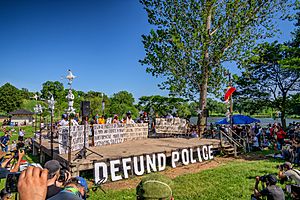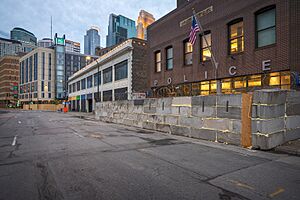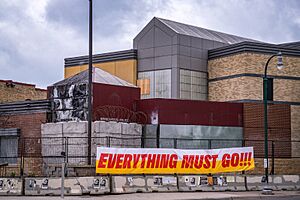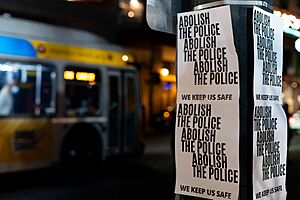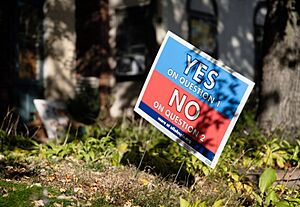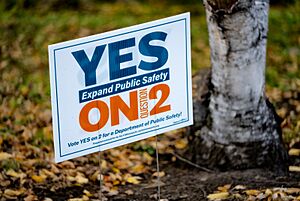Police abolition movement in Minneapolis facts for kids
Quick facts for kids Police abolition movement in Minneapolis |
|
|---|---|
| Part of George Floyd protests in Minneapolis–Saint Paul | |
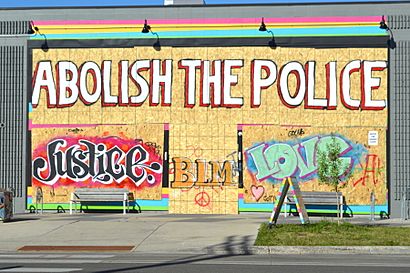
"Abolish the police" mural in Minneapolis, June 4, 2020
|
|
| Date | May 25, 2020 – November 2, 2021 (1 year, 4 months, 3 weeks and 6 days) |
| Location |
Minneapolis, Minnesota, United States
|
| Caused by |
|
| Goals |
|
| Methods | Protests, demonstrations, political campaign |
In the U.S. state of Minnesota, a police abolition movement in Minneapolis started after the murder of George Floyd. George Floyd was an African-American man who died during an arrest on May 25, 2020. A video of his death led to many protests in Minneapolis and around the world. In Minneapolis, the city's third police station was burned down on May 28, 2020. Police officers left the building during the protests.
After George Floyd's death, some local activists wanted to change the Minneapolis Police Department. They hoped to replace it with a new public safety system. They also wanted to use the police budget for other city programs. These programs included affordable housing, violence prevention, education, and food security.
On June 7, 2020, nine out of 13 members of the Minneapolis City Council made a promise. They pledged to "defund police." This promise got a lot of attention. However, it also caused a lot of disagreement. The city council members did not fully explain what "defund police" meant. The idea mostly faded away in the months that followed. Most Minneapolis residents, including many Black community members, did not want fewer police officers.
In 2020, discussions about changing police policies happened during a rise in violent crime. This crime affected people of color more often. By the end of 2020, the city council moved only 4.5 percent of the police budget. This money went to violence prevention programs. This was much less than what activists had asked for. The city council wanted to keep the same number of police jobs. But many officers left or could not work due to injuries. This meant the department had 200 fewer officers. Residents became upset because police were less visible. Response times to 911 calls also became slower.
In November 2021, voters had to decide on a special measure. This measure would remove rules about how many police officers the city needed. It would also change the Police Department's name to the Department of Public Safety. And it would shift control of the police from the Mayor to the City Council. The measure needed 51 percent of votes to pass. However, it failed with 56.2 percent voting against it.
Contents
Why People Wanted Change

Across the United States, many groups wanted to spend less money on police and prisons. They wanted to use that money for other services. These services included housing, jobs, community health, and education.
After George Floyd's death, many groups in Minneapolis cut ties with the police. These included Minneapolis Public Schools and the University of Minnesota. Leaders began asking for changes to the city's police force. They suggested reducing its size or even getting rid of it. This idea was not new in Minneapolis. A local group called MPD150 had suggested this in 2017. They believed that people who respond to crises should be the best trained for them. They thought social workers and mental health experts should be first responders.
Key Protest Events
March to Mayor Frey's Home, June 6, 2020
On June 6, 2020, thousands of people marched in Minneapolis. The event was led by the Black Visions Collective. Protesters gathered at Bottineau Field Park. They marched past the police union building. The march ended at Minneapolis Mayor Jacob Frey's home.
During the march, people chanted "George Floyd!" and "Black Lives Matter!" They also asked to defund the police. At Mayor Frey's home, the crowd asked him to come outside. They then asked if he supported getting rid of the city's police force. Mayor Frey said he did not support it. The crowd then booed him and told him to leave. United States Representative Ilhan Omar spoke at the rally. She said the city's police force was "beyond reform."
Powderhorn Park Rally, June 7, 2020
On June 7, 2020, a rally was held at Powderhorn Park. It was organized by Black Visions Collective and other groups. Nine of the 13 members of the Minneapolis City Council made a promise. They vowed to dismantle the city's police department.
Council President Lisa Bender and Vice President Andrea Jenkins were on stage. Other council members also took the pledge. These included Alondra Cano, Phillipe Cunningham, Jeremiah Ellison, Steve Fletcher, Cam Gordon, Andrew Johnson, and Jeremy Schroeder. Lisa Bender said that their past efforts to make small changes had failed. Council Member Linea Palmisano was there but did not take the pledge. Council Members Lisa Goodman and Kevin Reich were not there.
This pledge by nine council members was important. It meant they had enough votes to pass new laws. However, they did not immediately get rid of the police force. Details about what would happen next were not clear. Some activists wanted to use unarmed crisis responders. They also wanted to use the police department's $193 million budget for education, food, housing, and health care.
City Charter Changes
2020 Efforts
Council Approves Referendum
In June 2020, the city council voted to let people decide on a change to the city's rules. This change would remove the rule about how many police officers the city must have. It would also rename the Police Department. And it would shift control from the Mayor to the City Council. The city's rules said it needed at least 0.0017 police employees per resident.
Council Members Hire Security
Some city council members faced serious safety concerns after the pledge. In July 2020, it was learned that three council members hired private security guards. This cost the city $152,400. These were the same council members who had pledged to "end" the police department. Some people felt this was unfair. They thought it was wrong for councilors to have extra security when other residents did not.
Opposition from Black Community Leaders
In June 2020, the council's plan to change the city rules faced opposition. Some Black leaders and activists felt the council was just trying to please activists. They also felt the council had not listened enough to the Black community. They stressed the need to address public safety. Black residents were often victims of crime and police force.
Referendum Blocked
In August 2020, a city commission stopped the plan for a vote. They said they needed more time to review it. They also wanted more public input. The vote could still happen in November 2021. That was when the mayor and city council seats would be up for election.
"Defund Police" Pledge Changes Meaning
The "defund police" pledge from June 7, 2020, got a lot of media attention. But the idea mostly fell apart in the following months. Council members who made the pledge had different ideas about what it meant later on. Council Member Andrew Johnson said the pledge was "in spirit" and not meant to be taken literally. However, some people expected the police force to be completely removed. Others expected a big cut in the department's budget.
In October 2020, no council member directly said they still supported getting rid of the police. Some even refused to answer. During his 2021 re-election campaign, Council Member Phillipe Cunningham said he did not see the "defund police" sign at the rally. He also said he did not support the goal of the Black Visions Collective to abolish the police.
Violence Prevention Programs
By late 2020, surveys showed mixed feelings among Minneapolis residents. More than half of the city's residents did not want fewer police officers. This was happening as Minneapolis had its highest violent crime rates in decades.
In December, the city council voted to move $7.7 million from the police budget. This money went to mental health crisis teams and violence prevention programs. It also paid for civilian employees to handle non-emergency calls. The council also put $11.4 million of the police budget into a reserve fund. This money needed special approval for police hiring and overtime. The council voted to keep the police department's goal of 888 officers for 2022 and beyond.
The city still faced high violent crime rates after George Floyd's death. In June 2021, the city council approved $5 million in emergency funds. This money was for police overtime. It helped make up for some of the budget cuts from December 2020.
2021 Efforts
Council Tries Again
In January 2021, Council Members Phillipe Cunningham, Steve Fletcher, and Jeremy Schroeder proposed a new change. This change would remove the minimum number of police officers. It would also rename the Police Department to the Department of Public Safety. And it would put the new department under the City Council's control. Mayor Jacob Frey said he was against this plan. But the council members voted to put the change before voters in November 2021.
Outside Money for the Campaign
A group called the Open Society Policy Center gave $500,000. This money helped create a new group called Yes 4 Minneapolis. This group wanted to support the police abolition movement in Minneapolis. It also wanted to influence the 2021 elections. Yes 4 Minneapolis worked with local groups like Reclaim the Block and Black Visions. By the end of the campaign, Yes 4 Minneapolis spent over $3.5 million. Most of this money came from groups outside the city.
Fewer Police Officers
The city's rules required a minimum number of police officers. This was about 730 officers based on the population. By January 2021, Minneapolis had 817 officers. But 155 of them were on leave due to stress from the protests. By February 2020, only 638 officers could work. This was much lower than the 851 officers in 2019. Because of this shortage, police focused on 9-1-1 calls. The city was dealing with a rise in violent crimes. Police were less able to respond to all calls for help. Some residents even formed their own safety patrols. A group of north Minneapolis residents sued the city. They said the city was not hiring enough police. A judge ruled that the city must have the minimum number of police by June 30, 2022.
Activist Plan
In February, several groups started a petition. These groups included Yes 4 Minneapolis, Reclaim the Block, and TakeAction Minnesota. They wanted voters to decide the future of the police department. The petition aimed to change the city's rules. It would remove the minimum staffing rule. It would also rename the police department to a "public safety department." And it would shift control from the Mayor to the City Council.
On April 30, 2021, these groups delivered over 20,000 signatures. The city clerk certified 14,101 of them as valid. This was enough to move the proposal forward. It then went to the Charter Commission for review. For the change to happen, 51% of city votes had to approve it.
City Council Plan
On March 12, 2021, the city council approved a plan. This plan was similar to the activist petition. It would remove the minimum police staffing rule. It would also rename the Police Department to the Department of Public Safety. And it would put the new department under the City Council. Only two council members voted against it. The city's Charter Commission had until August 2021 to review this plan.
The council's plan was almost the same as the activist plan. The main difference was that the council's plan required some police officers. The activist plan allowed for no police officers at all, if not needed. In June 2021, the council members withdrew their plan. They did not want two similar proposals on the ballot.
Court Decisions
Some Minneapolis residents filed lawsuits. They wanted to stop the police force from being reduced. In July 2021, a judge ruled in favor of residents from North Minneapolis. This area has many minority residents. The judge said the city was breaking its own rules. It was not keeping at least 730 officers. The judge ordered the city to hire more police. By August 2021, the Minnesota Supreme Court agreed with this ruling.
Another group of residents sued to block the ballot measure. They said the wording was confusing. They argued it did not clearly say it would remove the minimum police staffing. A judge agreed on September 7, 2021. The city council then met and approved new, clearer wording. The Minnesota Supreme Court later overturned the judge's ruling. But by then, the city council had already approved the clearer language.
November 2021 Election
Ballot Measure
The final question on the November 2021 ballot was called City Question 2. It asked voters if they wanted to change the city's rules. This change would remove the Police Department. It would replace it with a Department of Public Safety. This new department would use a public health approach. The Mayor and City Council would decide its specific jobs. It could include police officers if needed. The minimum funding rule for police would be removed.
The measure needed at least 51 percent of votes to pass. If it passed, city officials would have 30 days to make the changes. The exact structure of the new department was not known before the vote. Its services, number of officers, and funding would be decided only if the measure passed.
Result
On November 2, 2021, Minneapolis voters rejected the ballot measure. About 56.2 percent voted "no." About 43.8 percent voted "yes." One survey showed that fewer Black voters supported the new safety department. They were worried about how cutting the police force might affect public safety.
What Happened Next
In December 2021, city officials put police funding back to $191 million. This was about the same amount as before George Floyd's death. The city also funded an $11.3 million Office of Violence Prevention. And it gave $6 million for mental health responders. The Minneapolis Park and Recreation Board's police department had cut ties with the city police. But they started working together again on May 4, 2022.
In June 2022, the Minnesota Supreme Court made a ruling. It said the city must follow its rules. It must work to hire at least 731 police officers. The city's police force had lost 300 officers after George Floyd's death.


